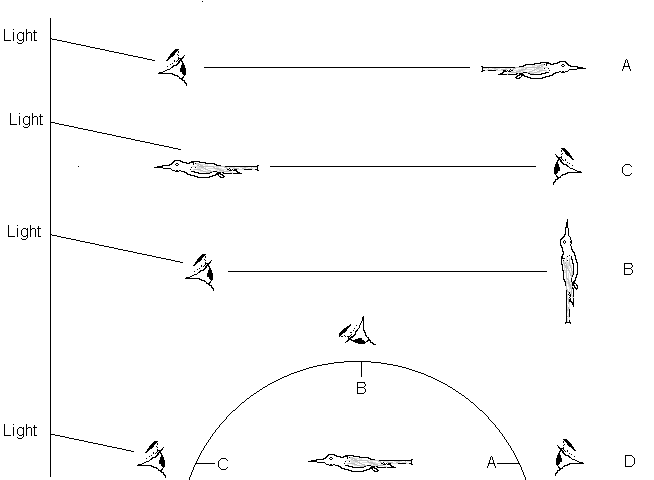|
|
|
Continued from Color in Birds
and Objective Structural Colours
The third class of colors, Subjective structural, prismatic
or metallic colours, change according to
the position of the light and the eye of the observer, and they always
change in the order of those in the rainbow. They are restricted, as a
rule, to the radii without cilia, and moreover to those parts of the feathers
which are not covered by others. The metallic portions of the radii
are composed of one row of compartments, which often partly overlap each
other like curved tiles. In the inside black or blackish-brown pigment
is collected; and each compartment is covered with a transparent colourless
layer of extreme thinness, e.g.
0.0008 mm. in Sturnus. The surface
of this coat is either smooth and polished as in Nectarinia, or exhibits
very fine longitudinal wavy ridges when the feather is violet, or numerous
small dot-like irregularities as in Galbula.

Diagram of positions for observing
the colour of Metallic Feathers.
The coating seems to act like a number of prisms.
All metallic feathers appear black when their surface is parallel to the
rays of the light in the same level with the eye and the light.
To the eye of the observer at A, in the lower part of the diagram above,
the metallic collar of Ptilorhis magnifica will appear absolutely black;
the eye at B will see it bright coppery red, and at C rich green;
the metallic feathers of the sides of the breast in the same bird will
change from black to green at B, and to blue at C. The beautiful
Pharomacrus mocinno changes from greenish bronze through golden green,
green, and indigo to violet. Oreotrochilus chimborazo in position
B exhibits the whole solar spectrum, namely, violet and red on the head,
followed by orange and green on the back, blue, violet, and lastly purple
on the long tail feathers. The red colours of the spectrum lie nearer towards
the position A, the blue colours towards C. The colours always appear in
the same order: no feathers are known, which when looked at from B towards
A, change from the red towards the blue end of the spectrum. In case two
or more of these spectra (of which we imagine the horny coating to be composed)
overlap each other, only a limited number of colours are able to reach
the eye of the observer. Thus in the theoretical case illustrated in the
diagram red only will be visible besides black.
A peculiar case is that of Artamia bicolor; the
pure white feathers of the underparts have no metallic gloss, but nevertheless
they seem to be prismatic, because in position A the underparts appear
bluish-white, in B delicately pale blue, and in position C pale grey.
Deviation from the normal coloration is more or
less pathological, and can be conveniently expressed by the term Heterochrosis.
The following are the chief cases:-
Albinism, caused by the pathological
absence of the black pigment, and often locally produced by a lesion of
the pulp of the growing feather; extreme instances are white Ravens and
Blackbirds.
Melanism produced by the superabundance
of black pigment, mostly causing the feathers to assume a darker or more
sooty colour. Melanistic specimens have been described of many birds,
such as Bullfinch, Skylark, and
in particular of the common Snipe, which in this phase has by some been
regarded as a distinct species, Sclopax saibinii.
Xanthochroism, mostly in originally red
or orange feathers; when the feathers are yellow instead of green, this
may possibly be a reversional step or a case of arrested development because
of the absence of the green-making superstructure.
Erythrism, the abnormal occurrence of red,
mostly confined to originally yellow or orange feathers, occasionally produced
by abnormal food, like cayenne pepper, or directly by the colouring matter
of Rubia tinctoria, one of the madder-worts. A certain correlation
between green and red is exhibited by the intensely green adult males of
Eclectus polychlorus, the females being bright red and the young of both
sexes being reddish, without any indication of green in the young male.
In Brazil "contrafeitos" of the various species of
Chrysotis are fashionable. Thse are produced by the rubbing in of
the cutaneous secretion of a Toad,
Bufo tinctorius, into the budding
feathers of the head, which then turn out yellow instead of green.
|
|
|





